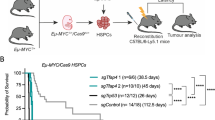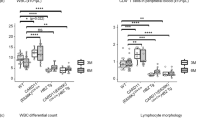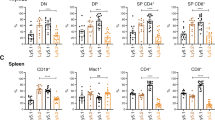Abstract
DNA breaks caused by recombination-activating gene 1 (RAG1) and activation-induced cytidine deaminase (AID) induce c-myc/immunoglobulin (Ig) heavy chain chromosomal translocations and thereby stimulate lymphomagenesis. However, constitutive expression of c-myc alone is not sufficient to induce lymphomas. Because RAG1 and AID activity occurs outside of Ig genes, we assessed whether these enzymes provide the secondary genetic lesions in Eμ c-myc transgenic mice to promote lymphoma development. We found that the tumor incidence and tumor phenotype in Eμ c-myc transgenic mice is similar in AID+/+, AID+/− and AID−/− backgrounds in both specific pathogen-free and conventional animal facilities, indicating that AID does not contribute to lymphoma development in Eμ c-myc transgenic mice. To examine the role of RAG proteins in Eμ c-myc mice, we examined Eμ c-myc transgenic mice that harbor the Ig-HEL heavy- and light-chain transgenes, and thus have reduced RAG expression in B cells. We found that tumor incidence was not affected by these Ig transgenes. However, we found that RAG1−/− Eμ c-myc mice exhibited accelerated tumor development compared to controls. This data combined with our finding that Eμ c-myc mice lived longer in the conventional facility than in the specific pathogen-free facility suggest an immune-mediated activity that suppresses lymphoma development.
This is a preview of subscription content, access via your institution
Access options
Subscribe to this journal
Receive 50 print issues and online access
$259.00 per year
only $5.18 per issue
Buy this article
- Purchase on Springer Link
- Instant access to full article PDF
Prices may be subject to local taxes which are calculated during checkout


Similar content being viewed by others
References
Adams JM, Harris AW, Pinkert CA, Corcoran LM, Alexander WS, Cory S et al. (1985). The c-myc oncogene driven by immunoglobulin enhancers induces lymphoid malignancy in transgenic mice. Nature 318: 533–538.
Crews S, Barth R, Hood L, Prehn J, Calame K . (1982). Mouse c-myc oncogene is located on chromosome 15 and translocated to chromosome 12 in plasmacytomas. Science 218: 1319–1321.
Crouch EE, Li Z, Takizawa M, Fichtner-Feigl S, Gourzi P, Montano C et al. (2007). Regulation of AID expression in the immune response. J Exp Med 204: 1145–1156.
Dalla-Favera R, Bregni M, Erikson J, Patterson D, Gallo RC, Croce CM . (1982). Human c-myc onc gene is located on the region of chromosome 8 that is translocated in Burkitt lymphoma cells. Proc Natl Acad Sci USA 79: 7824–7827.
Di Noia JM, Neuberger MS . (2007). Molecular mechanisms of antibody somatic hypermutation. Annu Rev Biochem 76: 1–22.
Dorsett Y, Robbiani DF, Jankovic M, Reina-San-Martin B, Eisenreich TR, Nussenzweig MC . (2007). A role for AID in chromosome translocations between c-myc and the IgH variable region. J Exp Med 204: 2225–2232.
Egle A, Harris AW, Bouillet P, Cory S . (2004). Bim is a suppressor of Myc-induced mouse B cell leukemia. Proc Natl Acad Sci USA 101: 6164–6169.
Eischen CM, Weber JD, Roussel MF, Sherr CJ, Cleveland JL . (1999). Disruption of the ARF-Mdm2-p53 tumor suppressor pathway in Myc-induced lymphomagenesis. Genes Dev 13: 2658–2669.
Fang W, Weintraub BC, Dunlap B, Garside P, Pape KA, Jenkins MK et al. (1998). Self-reactive B lymphocytes overexpressing Bcl-xL escape negative selection and are tolerized by clonal anergy and receptor editing. Immunity 9: 35–45.
Franco S, Alt FW, Manis JP . (2006a). Pathways that suppress programmed DNA breaks from progressing to chromosomal breaks and translocations. DNA Repair (Amst) 5: 1030–1041.
Franco S, Gostissa M, Zha S, Lombard DB, Murphy MM, Zarrin AA et al. (2006b). H2AX prevents DNA breaks from progressing to chromosome breaks and translocations. Mol Cell 21: 201–214.
Goodnow CC, Crosbie J, Adelstein S, Lavoie TB, Smith-Gill SJ, Brink RA et al. (1988). Altered immunoglobulin expression and functional silencing of self-reactive B lymphocytes in transgenic mice. Nature 334: 676–682.
Harris AW, Pinkert CA, Crawford M, Langdon WY, Brinster RL, Adams JM . (1988). The E mu-myc transgenic mouse. A model for high-incidence spontaneous lymphoma and leukemia of early B cells. J Exp Med 167: 353–371.
Korsmeyer SJ . (1992). Chromosomal translocations in lymphoid malignancies reveal novel proto-oncogenes. Annu Rev Immunol 10: 785–807.
Kotani A, Kakazu N, Tsuruyama T, Okazaki IM, Muramatsu M, Kinoshita K et al. (2007). Activation-induced cytidine deaminase (AID) promotes B cell lymphomagenesis in Emu-cmyc transgenic mice. Proc Natl Acad Sci USA 104: 1616–1620.
Mason DY, Jones M, Goodnow CC . (1992). Development and follicular localization of tolerant B lymphocytes in lysozyme/anti-lysozyme IgM/IgD transgenic mice. Int Immunol 4: 163–175.
Muramatsu M, Kinoshita K, Fagarasan S, Yamada S, Shinkai Y, Honjo T . (2000). Class switch recombination and hypermutation require activation-induced cytidine deaminase (AID), a potential RNA editing enzyme. Cell 102: 553–563.
Muramatsu M, Sankaranand VS, Anant S, Sugai M, Kinoshita K, Davidson NO et al. (1999). Specific expression of activation-induced cytidine deaminase (AID), a novel member of the RNA-editing deaminase family in germinal center B cells. J Biol Chem 274: 18470–18476.
Muschen M, Re D, Jungnickel B, Diehl V, Rajewsky K, Kuppers R . (2000). Somatic mutation of the CD95 gene in human B cells as a side-effect of the germinal center reaction. J Exp Med 192: 1833–1840.
Pasqualucci L, Neumeister P, Goossens T, Nanjangud G, Chaganti RS, Kuppers R et al. (2001). Hypermutation of multiple proto-oncogenes in B-cell diffuse large-cell lymphomas. Nature 412: 341–346.
Prasad VS, Temple MJ, Davisson MT, Akeson EC, Sidman CL . (1996). Heterogeneity of B-lymphoid tumors in E mu-myc transgenic mice. Cytometry 23: 131–139.
Raghavan SC, Swanson PC, Wu X, Hsieh CL, Lieber MR . (2004). A non-B-DNA structure at the Bcl-2 major breakpoint region is cleaved by the RAG complex. Nature 428: 88–93.
Ramiro AR, Jankovic M, Callen E, Difilippantonio S, Chen HT, McBride KM et al. (2006). Role of genomic instability and p53 in AID-induced c-myc-Igh translocations. Nature 440: 105–109.
Ramiro AR, Jankovic M, Eisenreich T, Difilippantonio S, Chen-Kiang S, Muramatsu M et al. (2004). AID is required for c-myc/IgH chromosome translocations in vivo. Cell 118: 431–438.
Shen HM, Peters A, Baron B, Zhu X, Storb U . (1998). Mutation of BCL-6 gene in normal B cells by the process of somatic hypermutation of Ig genes. Science 280: 1750–1752.
Smith DP, Bath ML, Harris AW, Cory S . (2005). T-cell lymphomas mask slower developing B-lymphoid and myeloid tumours in transgenic mice with broad haemopoietic expression of MYC. Oncogene 24: 3544–3553.
van Lohuizen M, Verbeek S, Scheijen B, Wientjens E, van der Gulden H, Berns A . (1991). Identification of cooperating oncogenes in E mu-myc transgenic mice by provirus tagging. Cell 65: 737–752.
Acknowledgements
We are grateful to Dr Matthew D Scharff and Dr Gillian Wu and to the Martin laboratory for helpful discussions and to Maribel Berru for technical help. This research is supported by a grant from the Canadian Cancer Society (16080) to AM, who is also supported by a Canada Research Chair award. AZ is supported by a Canadian Institute of Health Research Scholarship, whereas RMN is a Lymphoma Foundation Canada Fellow.
Author information
Authors and Affiliations
Corresponding author
Additional information
Supplementary Information accompanies the paper on the Oncogene website (http://www.nature.com/onc).
Supplementary information
Rights and permissions
About this article
Cite this article
Nepal, R., Zaheen, A., Basit, W. et al. AID and RAG1 do not contribute to lymphomagenesis in Eμ c-myc transgenic mice. Oncogene 27, 4752–4756 (2008). https://doi.org/10.1038/onc.2008.111
Received:
Accepted:
Published:
Issue Date:
DOI: https://doi.org/10.1038/onc.2008.111
Keywords
This article is cited by
-
Paradoxical role of Id proteins in regulating tumorigenic potential of lymphoid cells
Frontiers of Medicine (2018)
-
Tp53 deletion in B lineage cells predisposes mice to lymphomas with oncogenic translocations
Oncogene (2011)
-
Pre-B-cell leukemias in Btk/Slp65-deficient mice arise independently of ongoing V(D)J recombination activity
Leukemia (2011)
-
Selective ablation of the YxxM motif of IL-7Rα suppresses lymphomagenesis but maintains lymphocyte development
Oncogene (2010)
-
Oncogenic stress sensed by the immune system: role of natural killer cell receptors
Nature Reviews Immunology (2009)



